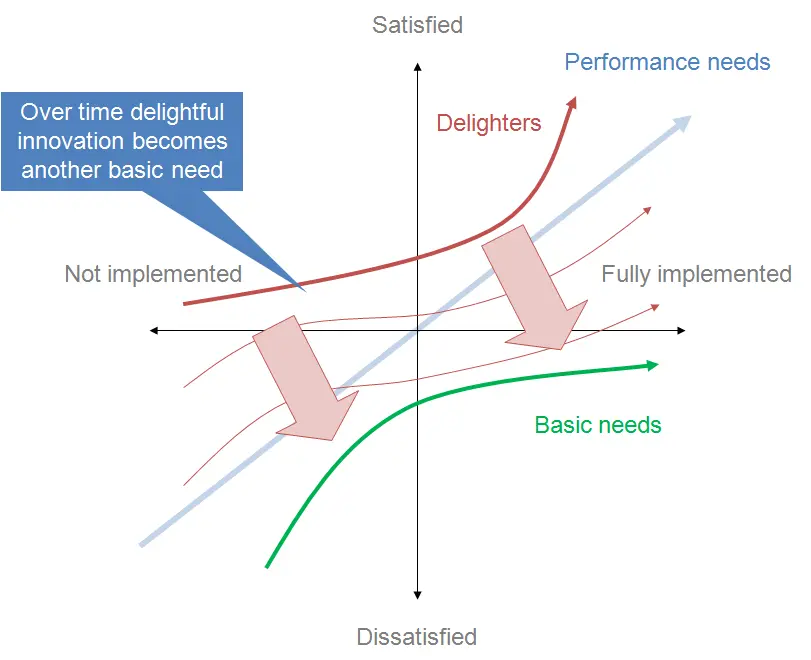What is Product Innovation: Definition, Types & Examples
Jul 17, 2024 • 9 min read
What is product innovation?
When people say product innovation, they often think of features. However, that lane of thought usually leads to bloated products that nobody likes.
Wikipedia defines product innovation as "the development of new products, changes in the design of established products, or use of new materials or components in the manufacture of established products."
This is a long, correct, and not very useful definition. It implies that adding features, changing designs, or using new materials leads to product innovation. However, this definition misses the most important ingredient—adding value to the product's users.
Product innovation is focused on bringing value to customers through new or improving existing products in ways that weren’t available before.
Types of Product Innovation
Companies can innovate in many ways, and these approaches are not mutually exclusive, as they can often work together. The best path depends on their goals, market situation, resources, and the industry.
- Incremental Innovation
This type of innovation focuses on refining existing products. Think about improvements and optimization to features, functionality, or design that make things better for customers. Incremental innovation focuses on getting the most out of what you already have.
- Radical Innovation
Radical innovation is all about creating something entirely new. These inventions usually disrupt existing markets or even create new ones. Think of groundbreaking technologies, such as AI, that change industries forever. This path can be risky and requires significant investment.
- Disruptive Innovation
This type, like radical innovation, brings new products or technologies that shake things up. It often starts small, targeting underserved markets with simpler or more affordable solutions. Over time, these disruptors can take down established leaders.
- Process Innovation
While this type isn't about the product itself, it focuses on improving efficiency, reducing production costs, and streamlining operations to make your product more competitive.
- Business Model Innovation
Business model innovation requires a whole new approach. It involves rethinking how you create, deliver, sell, and profit from your product. This could involve new revenue streams, distribution channels, or partnerships.
Why is Product Innovation Important?
- Loyal Customers
Customers love companies that understand their needs and serve them better than others. This is especially true for users who classify as technology enthusiasts, value innovation on its own, and are willing to become your first customers.
- Competitive Advantage
Innovations allow you to create new markets or enter existing ones. More importantly, they are a strategy for becoming the dominant player in your market and sustaining that leadership.
- Company Worth
Having innovative products, especially innovations protected by IP laws, increases your company's net worth. This can be a significant lever when looking for private investment, an IPO, or an acquisition.
The Path to Product Innovation
Many product development frameworks and theories lean on either continuous innovation or discontinuous innovation to get to successful product innovation.
Proponents of continuous innovation focus on interactive improvements, speed of learning, and experimentation. Discontinuous innovators focus on large breakthroughs, radical changes, and disruption of existing markets.
The reality is that both types of innovation need to work together for a product company to be innovative. Continuous and discontinuous innovations are like antagonistic muscles working together to provide strength in your arm or leg. No fitness trainer will tell you to train only your biceps or just the triceps.
Discontinuous innovation is how your team can gain a foothold in a market and quickly become a mainstream product. Once an established market player, the product switches to continuous innovation. The goal is to retain its competitive edge while working on the next breakthrough product.
Why Is Innovation Hard?
Lately, technical companies and startups have been mostly focused on short-term results. This is driven by the need to produce results to ensure the continuity of their business. That's especially true of VC-backed companies or public companies.
The challenge with that approach is that focusing only on short-term goals can easily lead in a direction that prevents them from realizing their full potential. Ironically, innovation delivered through short-term goals often leads to ... lack of innovation.
How does it feel when your organization isn’t innovating?
Feature creep
Focusing on feature requests from customers or matching competitors' capabilities leads to bloated products that no customer wants. It’s extremely tempting to indulge your first potential customers with the hope of buying your product. This slippery slope can turn your company from a product to a professional service.
Focus on Vanity Metrics
This often manifests as great Q-over-Q results, which don't lead to long-term customer relationships. This is when you focus on metrics that produce short-term results without delivering customer value.
Examples of that might be the number of new customers or new revenue. One of the best books on metrics is “Measure what matters,” not “Measure Everything”. Check out our key metrics blog post for more ideas on how to pick yours.
Lack of Alignment
Are people in your organization competing instead of working together? Do you have status reports that are filled with accomplishments but lack outcomes? Chances are that team members might not understand the direction in which the company should move and their role in achieving that outcome.
Complacency
Alright, you won! You are the #1 market player, and now you can switch gears and cruise. A year or two later, a competitor displaces you, and nobody in the company saw it coming.
A strong product vision can address these challenges. A vision provides the direction for small incremental steps.
What makes a great product vision?
Great product vision comes from the change you want to make in the world. It is not related to features, solutions, or logos you want to win but rather about defining why your company exists.
You will often hear product visions like:
- "Be the number 1 company in <a market segment>"
- "Become a billion-dollar company."
- "Build the best product in <a product category>"
While such product visions are definitely ambitious, there are several flaws in them:
-
The focus is on you and your organization. Product vision is not about you - it's about the difference you want to make.
-
They are too general. There are probably a trillion ways to become a billion-dollar company.
-
They don't inform employees why they are part of the organization.
This doesn't mean that the ability to monetize, set goals, and have healthy financials is bad. But it's important to think of them as an afterthought after understanding and delivering customer value. That's what will lead to a game-changing product. Not growing revenue 30% YoY.
Your product vision needs to convey the following:
-
The impact you will make.
-
Enable customers and team members to visualize it, so they can internalize it and relate to it.
-
Build the unique personality of your organization that differentiates it from everybody else.
Product vision comes before the actual product. The product is simply the means to achieve the change you want to see in the world.
Critical Components for Product Innovation Strategy
- Design
Product design is not just about having a visually appealing product. It is the interface through which users interact with your product. It should be in sync with the target customer's emotions, perceptions, and aspirations.
- Capabilities
Deliberately build the capabilities needed in your team to deliver the product. Great products don’t come from the skills and knowledge that teams already have. Great teams challenge themselves to discover new ways to solve a previously unseen problem.
- Learn and Iterate
Continuously learn and refine based on the feedback from the real world. Continuous Innovation gives speed. Discontinuous innovation gives direction. Together, they give velocity.
Product Innovation Examples
- BlackBerry vs iPhone
BlackBerry’s story is a great example of how “more of the same” rarely leads to an innovative process. BlackBerry built the concept of mobile phones by adding more keys, a slightly bigger screen, and some basic applications. This resulted in a device that was compelling primarily to business people. It never emerged from this narrow niche and was eventually displaced by other competitors.
Apple, on the other hand, created a device with no physical keyboard at all, added a touch screen, and created an ecosystem where developers could build apps and monetize them. This right away became a mass-market product, which, to date, is a market leader. Since then, Apple has continued improving its product by adding different cameras, sizes and colors, a payment processor, and much more.
- Nissan Leaf vs Tesla
The creation of electric vehicles marked a turbulent time in the automotive industry. Nissan's Leaf was initially a top seller, but Tesla quickly overtook them. Tesla's key innovation was introducing over-the-air updates, which enabled continuous product improvement and innovation long after selling the car.
This approach created a flywheel of ongoing enhancements, making Tesla cars progressively better with time. In contrast, traditional car makers relied on slow, shop-based updates, missing out on the rapid innovation cycle that over-the-air updates allowed.
- Kodak vs Nikon and Canon
Once, Kodak was a leader in the photography industry, but it couldn't keep up with the rise of digital technology and the transition from film to digital.
Nikon and Canon, meanwhile, continuously innovated with their DSLR models. Introducing higher resolution, image stabilization, high ISO performance, and 4K video capabilities helped them meet the evolving customer expectations.
This stream of innovation propelled them to leading market positions. As a result, Kodak had to pivot and focus on niches like printing solutions, photography chemistry, and instant photography to stay relevant.
How you can turn your vision into a product?
You now have a great product vision. How can you translate this into an actionable plan that leads to innovation?
The Kano model
 source: wikimedia
source: wikimedia
The Kano model categorizes product capabilities into three types:
- Must-Haves: Essential features that users expect to work, like car tires and doors. While crucial, excelling here doesn't impress customers.
- Performance: Features that get better with investment, like a car's efficiency or speed. The more you enhance these, the better the product becomes.
- Delighters: Unexpected features that wow customers, like umbrellas in car doors or Duolingo's green owl. These add unique value and personality to your product.
This framework helps you prioritize and structure your roadmap, ensuring you deliver innovation while covering all the basics.
The Icanpreneur Way
Icanpreneur helps entrepreneurs and product leaders turn vision into successful products or services using proven methodologies. It offers guidance and tools to:
- Express your business idea
- Define and test hypotheses in your business plan
- Validate ideas through customer interviews
Once validated, you can create a product roadmap to guide development.
Author
Product @ Icanpreneur. Coursera instructor, Guest Lecturer @ Product School and Telerik Academy. Angel Investor. Product manager with deep experience in building innovative products from zero to millions of users.
